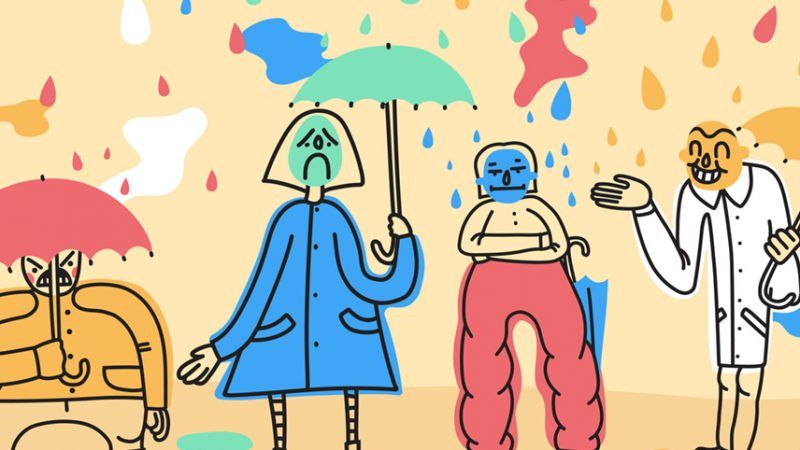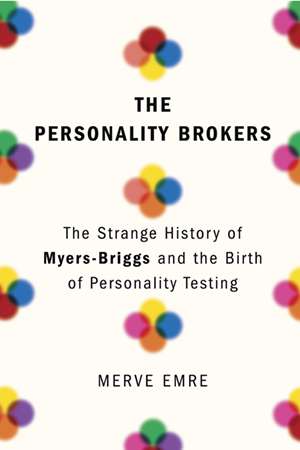Myers-Briggs Is Bunk
Why doesn't that stop people from taking the enduringly popular personality test?

The Personality Brokers: The Strange History of Myers-Briggs and the Birth of Personality Testing, by Merve Emre, Doubleday, 336 pages, $27.95

The official Myers-Briggs Type Indicator can be taken online for $50, but there are plenty of free knock-offs floating around the internet. I took two while writing this review. One says I'm ISTJ. The other typed me as ENTP.
For those who aren't familiar with the phenomenon, the test is made up of statements like "I prefer to stay home rather than go out" and "I prefer a tidy workplace," which the test-taker marks as either true or false. In the end you are assigned to one of 16 possible personality "types," based on the combination of results on four different axes: extroverted/introverted, sensing/intuitive, thinking/feeling, and judging/perceiving. As an ISTJ, I am introverted, sensing, thinking, and judging. Unless I am actually extroverted, intuitive, thinking, and perceiving. Whatever any of that means.
The Myers-Briggs test and others like it were huge in the corporate world in the 1980s and '90s. Individuals took them to see what kind of careers they should pursue; H.R. offices used them to decide who to hire or promote. In The Personality Brokers, Merve Emre explores how, precisely, this variety of psychobullshit rune-gazing was born.
Briggs and Myers were a mother and daughter who shared a personal fascination with psychology. Katharine Briggs, born in the last quarter of the 19th century, was one of the few women of her generation to gain a college degree. Like most female members of the upper-middle-class in her time, however, she didn't pursue a career, instead marrying young and raising a family. Rather than the chemistry she had studied at college, children became her research subject.
With an intensity that sounds frightening, Briggs believed she could develop a scientific approach to raising well-behaved, intelligent children. She seemed to do a good job with her daughter Isabel, and other parents soon sought her advice. Briggs was well-connected—her husband was a Washington bureaucrat, so of course she knew magazine editors. Soon she was writing columns for various publications about ideal parenting and child behavior.
As a devotee of psychology, she developed a correspondence with Carl Jung. She drew on his psychological theories to interpret the personalities of kids, the better to advise their parents on behavior management. The 16 "types" of the Myers-Briggs index directly relate to Jung's thinking, and Jung's approval of her ideas offered validation for her explorations.
But the commercial Myers-Briggs test came later, and it was far more her daughter's achievement. Isabel Myers was also fascinated with psychological type. But being a generation younger, she was better placed to pursue this professionally. Again, she had the advantages of social connection: Her husband was an attorney, and she happened to know Edward Northup Hay, one of the first personality consultants in the United States.
In 1943, Hay allowed Briggs—despite her having no formal qualifications or experience—to offer her test to his clients. The takers were few: mostly small outfits, sometimes just a single test for a potential employee. She continued working to perfect the evaluation, trying it on friends and neighbors.
The modernizing workplace in the first half of the 20th century was all about efficiency and productivity. Taylorism, a managerial philosophy of "scientific" efficiency in production, guided companies in trying to make the most of space and their workers' labor. Aptitude and intelligence testing could, in theory, help employers hire those most suited to a job. Businesses like Hay's tapped into this new market, promising to help identify the best candidates.
Some tests were not aptitudinal but focused on filtering out the "defective" or "subversive" types. (Unsurprisingly, given who they were made for, the assessments tended to show a lot of overlap between those two categories.) The Myers-Briggs test was different: There were no "wrong" answers or bad classifications. People simply had different traits that suited them for different roles.
Myers-Briggs achieved further acceptance when the Office of Strategic Services (a forerunner of the CIA) chose it as one of the tests to be given to newly recruited spies during World War II. Of course, Myers didn't know what made a good spy, and neither did anyone else—at least as far as could be measured on paper. Later, it became part of the battery of tests used by researchers at Berkeley in the 1950s studying the nature of creativity. They wanted to "type" artists and writers, so they recruited such notable subjects as Truman Capote and Norman Mailer, who as usual had no trouble talking about themselves.
Myers also convinced Educational Testing Service (ETS)—the firm that sells the SAT and other standardized tests—to include her product among their offerings. To the statisticians at ETS, the test was a nightmare. The answers were too subjective, the supposed traits being diagnosed too vague. Meanwhile, Myers was too possessive, insisting that all assessments be hand-graded. The folks at ETS had trouble reshaping the test into something useful, and it remained among their "experimental" evaluations rather than their standard range until the company finally dropped it in 1975.
By this time, Myers was aging and in poor health. She had to find a new publisher for the Myers-Briggs Type Indicator; her only taker, Consulting Psychologists Press, was a small outfit run from someone's basement in California. But that basement operation figured out how to turn the test into a goldmine.
Myers-Briggs was well-positioned, in the mid-'70s, to ride the wave of "self-actualization," the trend that brought us a dizzying array of personal growth programs and gurus. The new publisher offered the test not just to schools and corporations but to consumers as a "self-test"—individuals could buy the assessment and grade it themselves. This was a new market for such tests, which previously had only been sold to organizations, with the answer sheets sent back to the publisher for grading.
The DIY option was perfect for the "me" decade. People who felt unfulfilled could send off for a little green booklet with a self-scoring guide. Like reading a horoscope or doing a love quiz in Cosmopolitan, bored suburbanites could fill out the Myers-Briggs chart during the commercial breaks of Kojak and discover their "true type." By 1979, more than a million Myers-Briggs answer sheets had been sold.
The story of the Myers-Briggs follows the history of personality testing in the 20th century. Earlier self-improvement ideas, like those of Dale Carnegie, focused on doing the right thing. After the 1960s, the focus shifted to being the right thing. Neurolinguistic programming and self-hypnosis suggested that we could change ourselves. Myers-Briggs gave a softer option: It would help us know ourselves, uncritically. But the knowledge is a mirage. Reading through the questions is like looking at a script for a cold reading. Every answer could apply to everyone to some degree, possibly changing depending on mood.
The first half of The Personality Brokers is slow, with rather dilatory explorations of the lives of the two women. We don't get to the Myers-Briggs test itself until halfway through the text. But Emre, who teaches literature at Oxford, does a fine job of illustrating how the ideas for the evaluation came out of a particular time and social/cultural milieu. The test's creators (and intended audience) are people best described as affluent and anxious. Briggs wanted to perfect her children. Myers wanted to prove her worth as a professional, to justify her education, and to gain the respect of the psychology community.
She never really managed that last task. The test has been most influential among the kinds of businesses given to weekend "success seminars" in Ramada ballrooms. Today you'll still see people putting their Myers-Briggs type on their LinkedIn pages, the way others might mention their astrological sign on a dating profile. But not many scientists take it seriously.
At the end of her life, Myers established the Center for the Application of Psychological Type, the keepers of the Myers-Briggs flame. They control access to all her papers, and they defend her legacy with almost Scientological zeal—expecting Emre to spend $2,000 on a counseling course before they would even consider letting her access the archives. This cultish approach only reinforces the sense that what's behind the curtain is bunk.
Fewer corporations use the Myers-Briggs test now, although it lingers in various corners of the human resources world. (Emre wasn't the only one attending the counseling course.) This book is a useful study of how a dubious idea can gain traction if it arrives at the right time.
This article originally appeared in print under the headline "Myers-Briggs Is Bunk."


Show Comments (108)